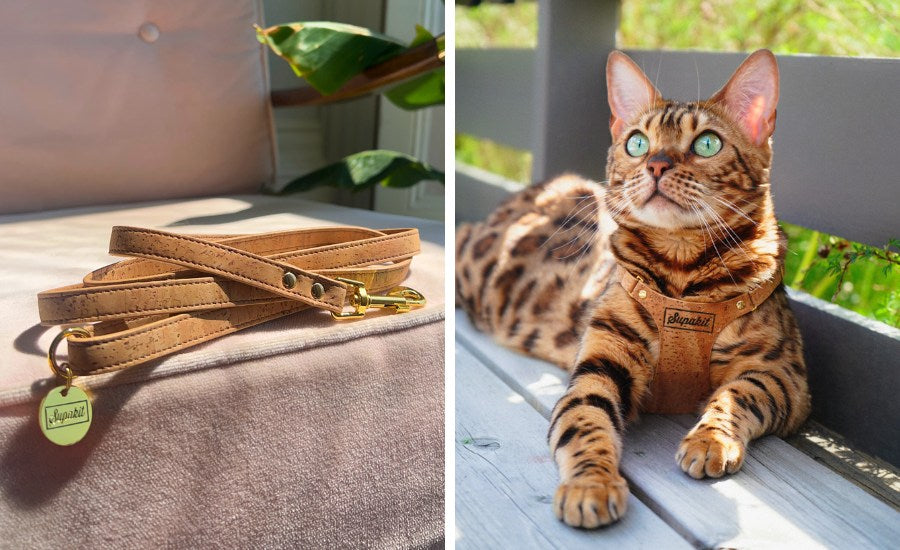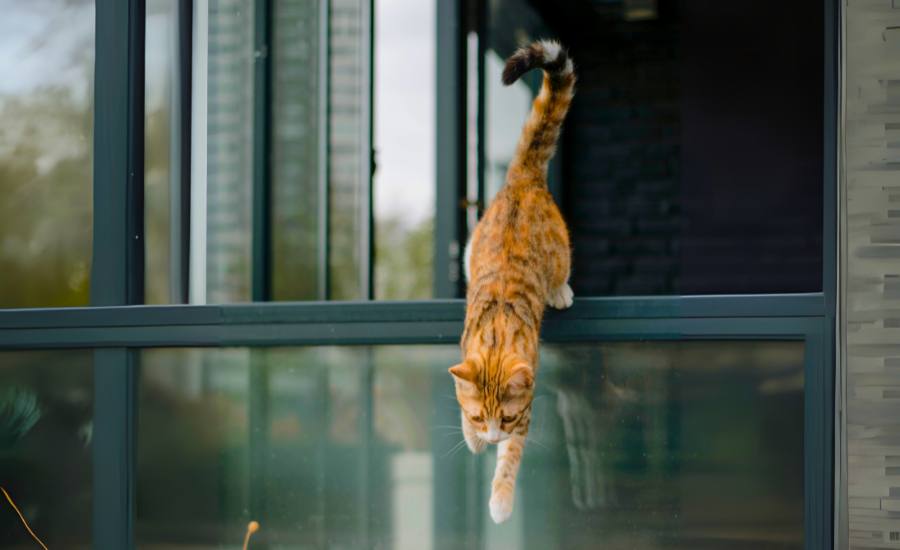Cat Teeth - Your Top 10 Questions Answered
Cat teeth may look quite different to our own, but it might surprise you to learn that they're actually very similar! Because of this, cats can experience many of the same dental issues as we do (1).
Despite this, it's common to have questions about how to provide the best care for your cat's teeth. Do you need to brush a cat's teeth? Do dental chews really work? And how do you know if your cat has got a sore tooth? To help out, this Pet Dental Health Month, we've gathered answers to the top 10 questions about cat dental care. Read on to find out what you need to know about your cat’s teeth and learn how to keep them in tip-top condition.
1. How Many Teeth Do Cats Have?

If you've ever gazed in wonder at your cat's fangs when they yawn, then you've already spotted their four oversized canines. But it might surprise you to know that adult cats have 30 teeth - that's almost as many as an adult human!
Domestic cats are descended from wildcats (2), and have inherited their food preferences. They are what's known as obligate carnivores, which means they can’t digest vegetation and can only survive on meat (3). As a result, cats don’t have any chewing teeth with flat surfaces that are specialised for chewing plants (4).
It's at the back of their mouth that you can see signs of their meat-based diet. In both the upper and lower jaw, their premolars are fused with their molar teeth to form something called carnassial teeth. Carnassials teeth are specially adapted for shearing meat into smaller pieces that can be swallowed whole. In our pet kitties, the carnassial teeth apply a powerful 28kg of pressure! (5)
2. What Are Those Tiny Cat Teeth At The Front Of Their Mouth For?

The tiny cat teeth at the front of your cat's mouth are their incisors. These usually play the role of slicing foods. Incisors are the first teeth to come into contact with food. They can grip it, pick it up, and deliver it to specialised teeth further back in the jaw.
Cats don’t have much use for their tiny incisors when hunting and eating meat. They rely on their canines and carnassials for this. However, when eating dry kibble food, some cats will collect their kibble using their tiny incisors. Breeds such as Persians are brachycephalic, meaning they have flat faces. Because of this, they struggle to pick up kibble using their incisors and instead grip it with their lips (5).
Cats do use their incisors during grooming. Their tongues are rough and work well as combs. However, the incisors can be used to nibble at tangles and dirt in the fur to help remove them.
3. Do Cats Have Baby Teeth?

Yes! Kittens are born with no teeth but later develop baby teeth. Baby teeth fall out before adulthood and are actually called deciduous teeth. When cats lose their baby teeth, their adult teeth grow in following a similar order to our own teeth (1).
4. Can Cats Get Cavities?

Cats can get many forms of dental disease including tooth decay. But they don’t get the same kind of cavities as humans. Partly, this is because cats don’t have flat biting surfaces with cracks and crevices. These features of our molars trap food and harbour bacteria, leading to cavities.
Another reason that cats don’t get cavities is that their saliva is more alkaline. Alkaline saliva is an adaptation to eating only meat. This does lead to a lot of dental calculus but makes caries (cavities) unlikely to form (6).
Cat Tooth Resorption
Cats suffer from something known as tooth resorption, also called feline odontoclastic resorptive lesions (FORLs). Cat tooth resorption happens when there is ongoing irritation or an injury to the tooth. Special cells start to attack the tooth and dissolve it. This usually begins on the enamel below the gumline, but eventually eats away at the tooth until the pulp and nerve are exposed.
These are not dental cavities as they are not caused by decay. But, they can look quite similar, as they can cause deep holes in the tooth. Tooth resorption is extremely painful and sadly very common. It is often detected at your cat's yearly veterinary exam, which is why keeping these regular appointments is so important.
Calculus And Plaque on Cat Teeth
Inflammatory gum diseases such as cat gingivitis are caused by a buildup of calculus. Calculus is the harder form of plaque. Plaque is a sticky film of bacteria that coats your teeth.
Daily brushing of teeth can remove the soft plaque before it hardens into calculus. Antibacterial rinses and pastes also help to prevent the development of plaque bacteria. Once plaque hardens into calculus, it will need to be removed by a veterinary professional. Just like us, our cats should be booked for professional tooth cleaning to prevent the onset of gum disease.
Cat Gum Disease
Cat gingivitis is more common than any other cat illness (7). Gum diseases like gingivitis and periodontitis are caused by inflammation in the gum. This leads to the slow destruction of the tissues that hold teeth in place. The end result is gum and tooth loss. Beyond these effects on the mouth, gum disease can also lead to wider infections through the body that attack systems such as the liver and kidneys (5).
5. How Do I Know If My Cat Has A Toothache?

Sadly, it may be difficult to notice that your cat has a toothache, even when he is in a lot of pain. Cats are excellent at masking pain. This is an adaptation from their past life in the wild. They hide their pain to prevent themselves from appearing weak, and becoming easy targets for their competition or predators.
The best way to keep on top of your cat’s dental health is to frequently brush their teeth. By doing so, you will become very familiar with what your cat’s mouth should look like. When there are changes, you will notice them right away.
If your cat is suffering from pain in his mouth, he may eat differently. They might select softer foods, or stop eating when you are watching them. Other signs that they might be suffering dental pain are unusual drooling or bloody saliva. This is definitely a sign that you should visit the vet for a dental checkup.
6. What Does It Mean If My Cat Has Bad Breath?
Bad bodily smells point to the presence of microbes like bacteria and fungi (8). If your cat's breath suddenly smells a lot worse than normal, this indicates that there are much more bacteria than usual (9). Therefore, bad breath could be an indicator of an oral infection.
7. Do Dental Chews Work?

For some owners, physically cleaning their cat’s teeth can be too stressful or time-consuming. A simple way to introduce cat dental care to your daily routine is to provide cat dental treats.
Research has shown that dental chews do significantly reduce plaque and calculus accumulation on cat’s teeth (10). Giving 1 dental chew per day can also reduce the severity of gingivitis, as well as plaque and calculus. But, dental chews and even toothbrushing do not mean that our cats don’t need dental care from the vet too (11).
8. Does A Cat's Diet Affect Their Dental Health?
Yes, cats’ diets can affect their dental health in two main ways. If their diet is not sufficient in calcium and other nutrients, then your cat's teeth and bones will not be strong (12). This is the same as for humans. A soft diet is also detrimental to a cat’s health. Wild cats evolved to use their teeth to shear through bones and cleave through meat. Eating only soft, squishy food has been shown to lead to gum disease in cats (13).
9. Do You Need To Clean A Cat’s Teeth?

Yes, modern scientific evidence shows that cat teeth cleaning is important in order to keep our kitties healthy (14). Humans have lived alongside cats as companions for thousands of years. Cats have been fully domesticated as household pets for centuries. For most of this time, no thought was given to cat dental care.
Vets now know that dental diseases such as tartar and gum disease are serious. These diseases are also the most common health issue found among our pet cats. They can also lead to further health issues such as systemic infections.
Luckily, dental diseases can be easily prevented by a combination of at-home care and regular treatments from veterinary professionals (12). There are a number of ways that you can keep your cat’s teeth clean.
10. How Do You Clean A Cat's Teeth?

How To Brush Cats’ Teeth
To brush your cat's teeth, position your cat with its back toward you, so that if it backs away, it backs into your lap. Place your palm on top of your cat’s head, and reach your thumb and middle or ring finger down to the cat's mouth, gently gripping either side. Lift your other fingers so as not to poke your cat in the eye or make him feel like he's in a headlock.
You can use your fingers to lift your cat’s lips. Then, gently brush the teeth in circular motions from the back of the teeth to the front. Once your cat is very good at having her teeth brushed on the outside surfaces, you can move on to brushing the inside surfaces too. You don’t need to clean the tops, as cats don’t have flat biting surfaces as we do. You can also ask your vet for a demonstration of how to brush cats’ teeth if you are not feeling confident.
How To Train Your Cat To Accept Toothbrushing
Toothbrushing a cat without any training can be unpleasant for both of you. The best way to train a cat to enjoy toothbrushing is to use active desensitisation, paired with positive reinforcement operant conditioning. What this means, is that you are going to make the toothbrush less scary by presenting it with things your cat likes. Then, you are going to teach the cat to behave well for toothbrushing by rewarding good behaviour.
Training using these professional methods is much less stressful than using punishment or forcing your cat to have his teeth brushed. You will get more predictable behavioural results, and build a closer relationship with your kitty.
To train your cat to enjoy toothbrushing:
- Introduce the toothbrush and toothpaste to your cat’ environment. Give your cat a reward when he approaches or interacts with the brush.
- Introduce the taste of toothpaste to your cat. Reward him when he sniffs or licks at the toothpaste.
- Work toward getting your cat comfortable with you holding his head, lifting his lips. and touching his teeth. Work in small steps and reward each one. Have patience and reward each good progression.
- Introduce the toothbrush and toothpaste to the behaviour from step 3. Again, do this gradually, and reward each small success.
Take a look at the following video to see how you might apply these techniques.
Brushing Your Cat's Teeth Part 4 - 4 Week Training Program
Cat Toothbrushes
There are many different types of cat toothbrush available. Some look like regular toothbrushes, but smaller. These can be difficult to use gently on a moving cat, as they have hard parts and abrasive bristles. You can cover any brush in a cat toothpaste or any tasty substance. This will help your cat enjoy toothbrushing more.
The finger toothbrush is easier to use and doesn't have hard edges that could accidentally injure your cat’s gums. However, you do run the risk of being bitten when using it. The finger toothbrush is rubbery in texture, and slides over your finger. The bristles are also rubbery and soft, and not too abrasive.
Free-standing toothbrushes are another fun way to get your cat to brush their own teeth. They resemble a toy, which sticks to a flat surface such as the ground or a window. Again, they are made from flexible, rubbery material with flexible bristles. They should be covered in a tasty cat toothpaste or another treat. The cat should then brush his own teeth by playing with the bristly toy.
Cat Toothpastes
You should never, ever, use human toothpaste to clean a cat’s teeth. Human toothpastes contain a lot of fluoride, which could make your cat seriously ill.
There are plenty of cat toothpastes available from pet shops and vet practises. Cat toothpaste is usually flavoured in a way cats love, such as with chicken or beef. Cat toothpastes are fluoride-free, and so are safe for your cat. You can apply toothpaste using a cat toothbrush, or with a finger or cloth such as medical gauze.
Cat Dental Sprays
Dental sprays can be purchased from your vet, and contain ingredients that limit plaque and tartar buildup. While physical abrasion of the teeth is essential to good dental care, these sprays are still beneficial, even when used alone. You can also use sprays alongside other cat dental care such as a brushing routine or dental treats.
Related posts: 'What Have You Always Wanted To Ask A Vet?' and 'Maintaining A Healthy Weight For Your Cat'
References
-
Shapiro, H.H. (1938). Growth in the Dental Arches of the Cat. Journal of Dental Research, [online] 17(5), pp.349–357. Available at: https://journals.sagepub.com/doi/abs/10.1177/00220345380170050101?journalCode=jdrb [Accessed 15 Jan. 2022].
-
Driscoll, C.A., Clutton-Brock, J., Kitchener, A.C. and O’Brien, S.J. (2009). The Taming of the cat. Genetic and archaeological findings hint that wildcats became housecats earlier--and in a different place--than previously thought. Scientific American, [online] 300(6), pp.68–75. Available at: https://www.ncbi.nlm.nih.gov/pmc/articles/PMC5790555/ [Accessed 15 Jan. 2022].
-
Bradshaw, J.W.S., Goodwin, D., Legrand-Defrétin, V. and Nott, H.M.R. (1996). Food selection by the domestic cat, an obligate carnivore. Comparative Biochemistry and Physiology Part A: Physiology, [online] 114(3), pp.205–209. Available at: https://www.sciencedirect.com/science/article/abs/pii/0300962995021337 [Accessed 15 Jan. 2022].
-
Verbrugghe, A. and Hesta, M. (2017). Cats and Carbohydrates: The Carnivore Fantasy? Veterinary Sciences, [online] 4(4), p.55. Available at: https://www.mdpi.com/2306-7381/4/4/55/htm [Accessed 15 Jan. 2022].
-
Girard, N. and Servet, E. (2020). Nutrition and oral health in cats. [online] Encyclopedia of feline clinical nutrition. Available at: https://vetacademy.royalcanin.es/wp-content/uploads/2020/09/10.Nutricao-e-Saude-Oral-em-Gatos.pdf [Accessed 15 Jan. 2022].
-
Chandler, E.A., Gaskell, R.M. and Gaskell, C.J. (2008). Feline Medicine and Therapeutics. Third Edition ed. [online] Google Books. Blackwell Publishing.
-
Lund, E., Armstrong, J., Kirk, C., Kolar, L. and Klausner, J. (1999). Health status and population characteristics of dogs and cats examined at private veterinary practices in the United States. JAVMA, [online] 214(9). Available at: https://citeseerx.ist.psu.edu/viewdoc/download?doi=10.1.1.204.1143&rep=rep1&type=pdf [Accessed 15 Jan. 2022].
-
Khanna, K. (2021). Microbial Origins of Body Odor | ASM.org. [online] American Society for Microbiology. Available at: https://asm.org/Articles/2021/December/Microbial-Origins-of-Body-Odor [Accessed 15 Jan. 2022].
-
Scully, C. and Greenman, J. (2012). Halitology (breath odour: aetiopathogenesis and management). Oral Diseases, [online] 18(4), pp.333–345. Available at: https://onlinelibrary.wiley.com/doi/full/10.1111/j.1601-0825.2011.01890.x [Accessed 15 Jan. 2022].
-
Gorrel, C., Inskeep, G. and Inskeep, T. (1998). Benefits of a “Dental Hygiene Chew” on the Periodontal Health of Cats. Journal of Veterinary Dentistry, [online] 15(3), pp.135–138. Available at: https://journals.sagepub.com/doi/abs/10.1177/089875649801500304 [Accessed 15 Jan. 2022].
-
Ingham, K.E., Gorrel, C. and Bierer, T.L. (2002). Effect of a Dental Chew on Dental Substrates and Gingivitis in Cats. Journal of Veterinary Dentistry, [online] 19(4), pp.201–204. Available at: https://journals.sagepub.com/doi/abs/10.1177/089875640201900403 [Accessed 15 Jan. 2022].
-
Logan, E.I. (2006). Dietary Influences on Periodontal Health in Dogs and Cats. Veterinary Clinics of North America: Small Animal Practice, [online] 36(6), pp.1385–1401. Available at: https://www.vetsmall.theclinics.com/article/S0195-5616(06)00104-5/fulltext [Accessed 15 Jan. 2022].
-
Watson, A. (1994). Diet and periodontal disease in dogs and cats. Australian Veterinary Journal, [online] 71(10), pp.313–318. Available at: https://onlinelibrary.wiley.com/doi/abs/10.1111/j.1751-0813.1994.tb00905.x [Accessed 15 Jan. 2022].
-
Rodan, I. and Heath, S. (2015). Feline Behavioral Health and Welfare. [online] Google Books. Elsevier Health Sciences.







